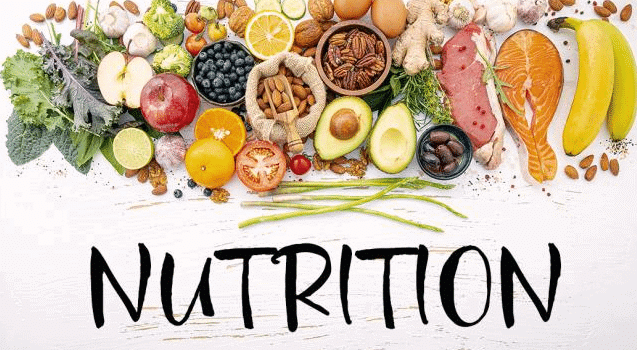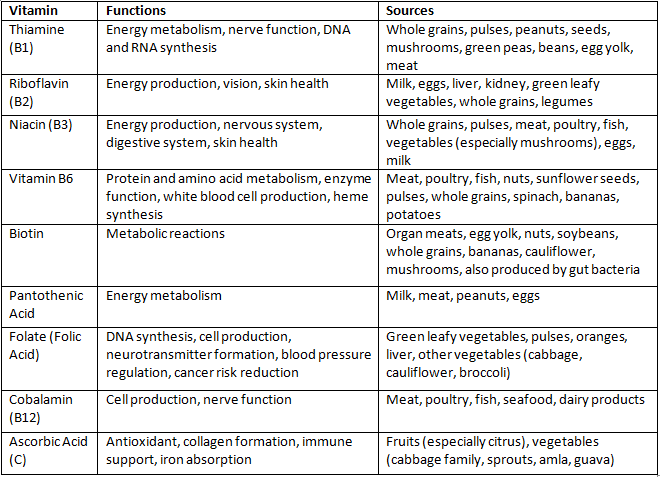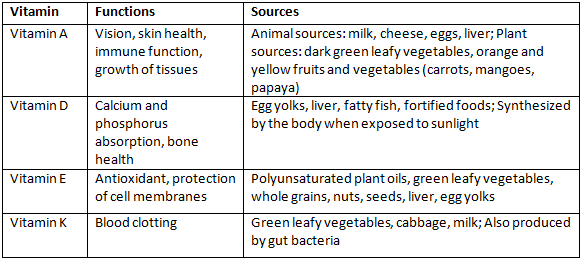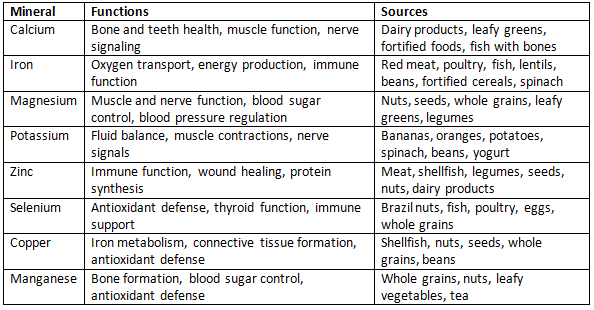Sports and Nutrition - 1 Chapter Notes | Physical Education Class 12(XII) - Notes & Model Test Papers - Humanities/Arts PDF Download
Balanced Diet
A balanced diet is essential for maintaining good health and well-being. It ensures that our body receives all the necessary nutrients in the right proportions. Foods can be grouped based on their nutrient content, and each group plays a crucial role in our diet. Here are the different food groups and their contributions:
Cereals and Millets:
- Include foods like wheat, rice, jowar, bajra, and ragi.
- Major source of carbohydrates.
- Also provide protein (improves when combined with pulses), B-vitamins, iron (e.g., bajra), and calcium (e.g., ragi).
Pulses:
- Include whole and washed dals like red gram, Bengal gram, lentils, and green gram.
- Provide protein (quality improves with cereals), carbohydrates, and B-vitamins (especially thiamine and niacin).
- Whole pulses also offer iron and fiber. sprouts provide vitamin C.
Milk and Milk Products:
- Include milk, curd, cheese, paneer, and khoa.
- Major source of good quality protein, along with carbohydrates, fat (in whole milk), calcium, and riboflavin.
- Generally provide all nutrients except iron and vitamin C.
Meat and Meat Products:
- Include meat, fish, chicken, eggs, and related products.
- Major source of good quality protein, along with B-vitamins, retinol (from liver), and calcium (from fish).
- Eggs are particularly rich in various nutrients.
Nuts and Oil Seeds:
- Include groundnuts, almonds, cashew nuts, sesame seeds, and pistachios.
- Good source of fat, protein, B-vitamins, calcium, and other minerals.
Green Leafy Vegetables (GLVs):
- Include mustard, bathua, fenugreek leaves, and spinach.
- Good source of carotene (vitamin A), B-vitamins (especially riboflavin and folic acid), iron (especially from mustard and bathua), and fiber.
- Also provide calcium, although oxalates in GLVs can hinder calcium absorption.
Root Vegetables:
- Include potato, colocasia, sweet potato, and yam.
- Major source of carbohydrates. yellow yam also provides carotene.
Other Vegetables:
- Include brinjal, ladyfinger, beans, cauliflower, and others.
- Provide fiber, vitamins, and some minerals.
Fruits:
- Variety of fruits available, each with different nutrient profiles.
- Include a combination of fruits for a range of nutrients.
- Examples: mangoes, apricots, oranges, papaya (rich in carotene); citrus fruits (e.g., oranges, guavas. for vitamin C. dried fruits (e.g., dates, raisins. for iron.
Sugar and Jaggery:
- Source of carbohydrates. jaggery also contains iron.
Fats and Oils:
- Include ghee, oil, and butter.
- Rich source of fat. butter and fortified oils provide vitamin D.
Classification by Function
Group 1: Energy-Giving Foods:
- Cereals and roots and tubers
- Sugar and jaggery
- Fats and oils
Group 2: Body-Building Foods:
- Meat and meat products, fish, eggs, or poultry
- Nuts and oilseeds
Group 3: Protective or Regulatory Foods:
(i) Fruits
- Yellow and orange fruits (e.g., mango, papaya)
- Citrus fruits (e.g., lemon, orange, mausambi)
- Other fruits (e.g., apple, banana)
(ii) Vegetables
- Green Leafy Vegetables (e.g., spinach, mustard, fenugreek)
- Yellow and orange vegetables (e.g., carrot, pumpkin)
- Other vegetables (e.g., beans, okra, cauliflower)
(iii) Root Vegetables
- Potatoes and yam (arvi) are rich in carbohydrates
Importance of a Balanced Diet:
- A balanced diet ensures that all nutrients are consumed in the right amounts and proportions.
- Each meal should include foods from all food groups to provide essential nutrients.
- For example, a balanced breakfast could include:
- Energy-giving foods (e.g., bread with jam)
- Body-building foods (e.g., eggs for non-vegetarians or paneer/sprouts for vegetarians, along with milk)
- Protective foods (e.g., fruit or fruit juice)
A balanced diet is one that contains a variety of foods in the right quantities and proportions to meet the body's needs for calories, minerals, vitamins, and other nutrients, with a small surplus to prepare for times when food is scarce.
Nutrition

Nutrients are the chemical substances in foods that are necessary for the body to function properly. They are required for providing energy, growth, and maintenance of the body. The main types of nutrients include:
- Carbohydrates. These are the body’s primary source of energy. They are found in foods like bread, rice, and fruits.
- Proteins. Essential for growth and repair of tissues, proteins are found in meat, fish, eggs, dairy products, and legumes.
- Fats. These provide a concentrated source of energy and are important for absorbing certain vitamins. Fats are found in oils, butter, nuts, and fatty fish.
- Vitamins. These are required in small amounts for various physiological functions. Different vitamins have different roles, such as vitamin C for the immune system and vitamin D for bone health.
- Minerals. Essential for various bodily functions, minerals like calcium (for bones) and iron (for blood) are required in specific amounts.
- Water. Vital for life, water is involved in numerous bodily processes, including digestion, absorption, and temperature regulation.
- Fiber. Although not a nutrient in the traditional sense, fiber aids in digestion and helps maintain a healthy gut. It is found in whole grains, fruits, and vegetables.
Macronutrients: Their Functions and Sources
Macronutrients are the nutrients that are required by our body in large quantities as they provide the energy necessary for the body to function properly. There are three main types of macronutrients: Carbohydrates, Proteins, and Fats.
Carbohydrates
Carbohydrates are the body’s primary source of energy. They are made up of carbon, hydrogen, and oxygen and provide 4 kcal of energy per gram. Carbohydrates can be classified into three types:
- (i) Monosaccharides: These are the simplest form of sugar and include glucose, fructose, and galactose.
- (ii) Disaccharides: These are formed when two monosaccharides combine. Examples include maltose (glucose + glucose), lactose (glucose + galactose), and sucrose (glucose + fructose). Disaccharides are found in fruits, milk, and commercially produced sweets.
- (iii) Polysaccharides: These are made up of more than two monosaccharides and include starches and fiber. Examples include whole grain cereals, rice, oats, potatoes, bread, legumes, corn, and flour. Polysaccharides are also known as complex sugars.
Function of Carbohydrates
Carbohydrates are essential for several reasons:
- Energy Production: They are the main source of energy for the body, providing 4 Kcal per gram.
- Brain and Nervous System Function: Carbohydrates are the primary energy source for the brain, nervous system, and red blood cells.
- Protein Sparing: When carbohydrate intake is sufficient, proteins can be used for their essential functions rather than being broken down for energy.
- Fat Metabolism: Carbohydrates are necessary for the proper utilization of fats in the body.
Sources of Carbohydrates
Carbohydrates are found in a variety of foods, including:
- Fruits: Such as guava, apple, orange, and pineapple.
- Cereal Grains: Such as rice, whole wheat flour, and other whole grain cereals.
- Legumes: Such as beans, lentils, and peas.
- Root Vegetables: Such as potatoes and carrots.
- Dairy Products: Such as milk and yogurt.
- Sugar and Sweeteners: Such as sugar, honey, and jaggery.
- Processed Foods: Such as pasta, bread, and cereals.
Dietary Fiber
Dietary fiber, also known as roughage, is a type of carbohydrate that is not digested by the body. It provides several health benefits, including:
- Feeling of Fullness: Dietary fiber helps to keep you feeling full, which can aid in weight management.
- Smooth Digestion: It adds bulk to the stool and helps in the smooth elimination of waste.
- Disease Prevention: High fiber intake is associated with a lower risk of diseases such as cancer, diabetes, and heart disease.
- Cholesterol Lowering: Fiber has been shown to have a cholesterol-lowering effect.
Sources of Dietary Fiber
Fiber is found in:
- Whole Grain Cereals: Such as whole wheat flour and oats.
- Whole Pulses: Such as lentils, beans, and chickpeas.
- Vegetables: Such as green leafy vegetables, peas, and carrots.
- Fruits: Such as guava, apple, and orange.
Proteins
Proteins are made of nitrogen-containing amino acids, which are linked together in chains to form different types of proteins in the body.
Essential and Non-Essential Amino Acids
- There are 20 amino acids that can be combined in different sequences to make different proteins.
- Nine of these amino acids cannot be made by the body and must be obtained from food. These are called Essential Amino Acids (EAA). The other amino acids can be made by the body and are called non-essential amino acids.
Complete, Partially Complete, and Incomplete Protein Foods
- Complete Protein Foods. These foods contain all essential amino acids in the right amounts. Examples include eggs, milk, meat, and soybean.
- Partially Complete Protein Foods. These foods are missing one essential amino acid. For example, cereals lack lysine, and pulses lack methionine. To improve protein quality, cereals and pulses can be eaten together or with complete protein foods.
- Incomplete Proteins. These proteins are missing more than one essential amino acid. An example is maize protein.
Protein Requirements
- The protein requirement for Indian adults is 0.83 grams per kilogram of body weight. For example, a 60 kg man needs 54 grams of protein per day, and a 55 kg woman needs 46 grams.
- Protein intake should be 10-15% of total energy consumed and should not exceed 35%.
- During sports and exercise, protein needs may increase to 2 grams per kilogram of body weight depending on the type and intensity of the activity.
- Both too little and too much protein can be harmful, so it is important to consume protein within the recommended range.
Fats (Lipids)
Lipids, also known as dietary fats, include both oils and fats. Oils are typically liquid at room temperature, while fats are solid. The difference in their physical state is due to the types of fatty acids they contain.
Fatty Acids: The Building Blocks of Fats and Oils
- Fatty acids are classified into saturated and unsaturated fats based on the presence of double bonds in their chemical structure:
- Saturated Fatty Acids (SFA) contain no double bonds. Monounsaturated Fatty Acids (MUFA) contain one double bond. Polyunsaturated Fatty Acids (PUFA) contain more than one double bond.
- The proportion of saturated and unsaturated fatty acids determines whether a lipid is solid or liquid at room temperature. Lipids with a higher percentage of saturated fatty acids are solid (fats), while those with a higher percentage of unsaturated fatty acids are liquid (oils).
Health Implications of Different Types of Fats
Saturated Fats, also known as animal fats, are associated with increased health risks, particularly heart disease. They raise total and LDL (“bad”) cholesterol levels. It is recommended to limit saturated fat intake to less than 7% of total calories. Common sources include desi ghee, butter, cheese, cream, red meats, baked goods, and full-fat dairy products. Coconut and palm oils are also high in saturated fats.
Monounsaturated and Polyunsaturated Fats, when they replace saturated fats in the diet, can help reduce blood cholesterol levels and lower the risk of heart disease. Sources of monounsaturated fats include canola, olive, peanut, palmolein, rice bran, and sesame oils, as well as nuts like walnuts. Sources of polyunsaturated fats include vegetable oils such as mustard, soybean, corn, safflower, and sunflower oils, as well as flaxseed.
- Fats can be obtained from both visible and invisible sources.
- Visible sources include ghee, butter, and cooking oil.
- Invisible sources consist of nuts, cereals, pulses, milk, eggs, and meat.
- Invisible fat plays a significant role in the overall fat and essential fatty acid content of the diet, depending on the food items present.
- The total fat intake (both visible and invisible) should account for 15-30% of total calories.
- Visible fat intake should be limited to 20-30 grams per day, depending on individual physical activity levels.
Cholesterol:
- Cholesterol is a fat-like substance produced by the body and is essential for various physiological processes, including:
- Cell membrane structure: Cholesterol is a crucial component of cell membranes, contributing to their integrity and fluidity.
- Bile acid production: Cholesterol is necessary for the production of bile acids, which aid in the digestion and absorption of dietary fats.
- Hormone synthesis: Cholesterol is involved in the production of sex hormones and other steroid hormones.
- However, excess cholesterol in the blood can lead to the formation of plaques in the walls of blood vessels, reducing blood flow and increasing the risk of heart attacks.
- Dietary cholesterol is found only in animal products such as egg yolks, butter, organ meats, beef, and chicken. Vegetable oils do not contain cholesterol.
- While excess dietary cholesterol can raise blood cholesterol levels, its impact is not as significant as that of saturated and trans fats.
Trans-Fatty Acids:
- Trans-fatty acids are created through a process called hydrogenation, which involves adding hydrogen molecules to unsaturated fatty acids found in vegetable oils to make them saturated or solid.
- Hydrogenated oils are used in food production for their textural and stability properties.
- Trans-fatty acids occur naturally in small amounts in beef, lamb, and dairy products. However, the primary sources of trans-fats in the diet are processed foods such as cookies, biscuits, snacks, pastries, and other fried foods.
- Trans-fatty acids have a similar effect on blood cholesterol levels as saturated fats and dietary cholesterol. They can raise low-density lipoprotein (LDL) cholesterol, often referred to as "bad" cholesterol, and may also lower high-density lipoprotein (HDL) cholesterol, known as "good" cholesterol.
Water
- Water is crucial for life and makes up about 60% of an individual's body weight. It is an inorganic compound consisting of hydrogen and oxygen.
- Water is the primary component of all body fluids, including blood, saliva, digestive juices, urine, feces, sweat, and perspiration.
- Water plays a vital role in regulating body temperature and acts as a universal solvent. It bathes and moistens body cells, acting as a lubricant, and is also an important lubricant for joints.
- The body primarily obtains water through the ingestion of liquids, such as water, tea, coffee, fruit juices, and aerated drinks. Water is also present in foods like vegetables, fruits, milk, cereals, and pulses, although in invisible form.
- It is essential to consume clean, safe, and wholesome water to avoid waterborne diseases such as diarrhea, dysentery, and cholera.
Each red blood cell contains hemoglobin, an iron-containing protein responsible for transporting oxygen from the lungs to other parts of the body. Hemoglobin is made up of subunits, each containing a heme group. The heme group consists of an iron atom capable of binding to one oxygen molecule.
Vitamins
- Vitamins are essential chemicals that our body requires in small amounts to function properly. They play various roles, mostly acting as 'helpers.' For example, many B-vitamins assist the body in utilizing proteins, fats, and carbohydrates.
- Vitamins are categorized into two groups:
- Water-soluble vitamins include all B vitamins and vitamin C. The excess amount of water-soluble vitamins that the body does not use is excreted through the kidneys and eliminated from the body as urine or stool. The body needs water-soluble vitamins in frequent, small doses, and they are unlikely to reach toxic levels.
- Fat-soluble vitamins consist of vitamins A, D, E, and K. These vitamins are stored in the body cells and are not expelled from the body as easily as water-soluble vitamins. They are more prone to reaching toxic levels if a person ingests too much of these vitamins.
Vitamins are classified into two types: water-soluble vitamins and fat-soluble vitamins.
Water-Soluble Vitamins
- These vitamins dissolve in water and are not stored in the body. They are excreted through urine, so regular intake is necessary. Water-soluble vitamins include B-complex vitamins and vitamin C.
Functions and Sources of Water-Soluble Vitamins:
Fat-Soluble Vitamins
- These vitamins dissolve in fats and are stored in the body’s fatty tissues. They include vitamins A, D, E, and K. While they are essential for health, excessive intake can lead to toxicity.
Functions and Sources of Fat-Soluble Vitamins:
Minerals
Minerals are inorganic elements essential for various physiological functions in the body. They are categorized into two groups:
- Macro-Minerals: Required in larger amounts.
- Micro-Minerals (Trace Minerals): Needed in smaller quantities.
Functions and Sources of Important Macroand Micro-Minerals:

Macro-minerals
Sodium:
- Sodium is essential for maintaining proper fluid balance in the body.
- It plays a crucial role in regulating the alkalinity and acidity of body fluids.
- Sodium is also important for nerve transmission and muscle contraction.
- Sources: Table salt, soy sauce, processed foods (which contain large amounts of sodium), and small quantities in milk, breads, green leafy vegetables, and unprocessed meats.
Chloride:
- Chloride is necessary for maintaining proper fluid balance in the body.
- It is a component of stomach acid, which is important for digestion.
- Sources: Table salt, soy sauce, processed foods (which contain large amounts of chloride), and small quantities in milk, meats, breads, and vegetables.
Potassium:
- Potassium is vital for maintaining proper fluid balance in the body.
- It is involved in nerve transmission and muscle contraction.
- Sources: Meats, milk, fresh fruits and vegetables, whole grains, and pulses.
Calcium:
- Calcium is important for the health of bones and teeth.
- It helps muscles relax and contract and is crucial for nerve functioning, blood clotting, blood pressure regulation, and immune system health.
- Sources: Milk and milk products, fish with bones (such as sardines), fortified soy milk, leafy greens (such as broccoli and mustard leaves), and pulses.
Phosphorus:
- Phosphorus is found in every cell of the body and is important for bone and teeth health.
- It is part of the system that maintains acid-base balance in the body.
- Sources: Meat, fish, poultry, eggs, milk, and processed foods.
Magnesium:
- Magnesium is found in bones and is necessary for making proteins, muscle contraction, nerve transmission, and immune system health.
- Sources: Nuts and seeds, pulses, leafy green vegetables, seafood, and chocolate.
Sulphur:
- Sulphur is found in protein molecules and is an essential component of certain amino acids.
- Sources: Foods that contain protein, such as meats, poultry, fish, eggs, milk, pulses, and nuts.
Trace Minerals (Micro-Minerals)
- Trace minerals, also known as micro-minerals, are required by the body in very small amounts. While iron is classified as a trace mineral, the body needs a slightly larger quantity of iron compared to other micro-minerals.
Iron:
- Iron is an essential mineral found in every cell of the body.
- It is a crucial component of hemoglobin, which carries oxygen to cells, and myoglobin, which is necessary for muscle contraction.
- Iron is also important for energy metabolism, helping the body perform physical work.
- Additionally, iron is part of many enzymes involved in synthesizing proteins and genetic material, and it plays a role in taste perception, wound healing, fetal development, sperm production, and growth and sexual maturation.
Food Sources:
- Rich Sources: Organ meats, red meats, fish, poultry, egg yolks, whole pulses, whole grain cereals, dried fruits, dark green leafy vegetables (e.g., mustard greens, bathua), iron-enriched breads and cereals, fortified cereals.
- Other Sources: Meats, fish, poultry, whole grains, vegetables.
Zinc:
- Function: Zinc is essential for various biological processes, including immune function, protein synthesis, and wound healing.
- Food Sources: Meat, shellfish, legumes, seeds, nuts, dairy products, whole grains.
Iodine:
- Function: Iodine is a crucial component of thyroid hormones, which regulate metabolism, growth, and development.
- Food Sources: Seafood, iodized salt, dairy products, eggs, bread, and foods grown in iodine-rich soil.
Selenium:
- Function: Selenium acts as an antioxidant, protecting cells from damage.
- Food Sources: Meat, fish, eggs, dairy products, nuts, and whole grains.
Copper:
- Function: Copper is involved in iron metabolism and is a component of various enzymes.
- Food Sources: Shellfish, nuts, seeds, whole grains, beans, and organ meats.
Manganese:
- Function: Manganese is a cofactor for various enzymes involved in metabolism and antioxidant defense.
- Food Sources: Whole grains, nuts, leafy vegetables, and tea.
Fluoride:
- Function: Fluoride is involved in bone formation and helps prevent tooth decay.
- Food Sources: Fluoridated drinking water, fish, and tea.
Chromium:
- Function: Chromium helps regulate blood sugar levels by enhancing insulin action.
- Food Sources: Meat, whole grains, nuts, and some fruits and vegetables.
Molybdenum:
- Function: Molybdenum is a cofactor for certain enzymes involved in metabolism.
- Food Sources: Legumes, grains, nuts, and organ meats.
Other Trace Nutrients: Nickel, silicon, vanadium, and cobalt are also considered essential in very tiny amounts, although their specific functions and food sources are less well-defined.
|
12 videos|72 docs|31 tests
|
FAQs on Sports and Nutrition - 1 Chapter Notes - Physical Education Class 12(XII) - Notes & Model Test Papers - Humanities/Arts
| 1. What are the main macronutrients, and what roles do they play in a balanced diet? |  |
| 2. What are the differences between nutritive and non-nutritive components of a diet? |  |
| 3. How can I maintain a healthy weight through diet? |  |
| 4. Why is diet important for athletes and sports performance? |  |
| 5. What are some healthy sources of macronutrients? |  |




















